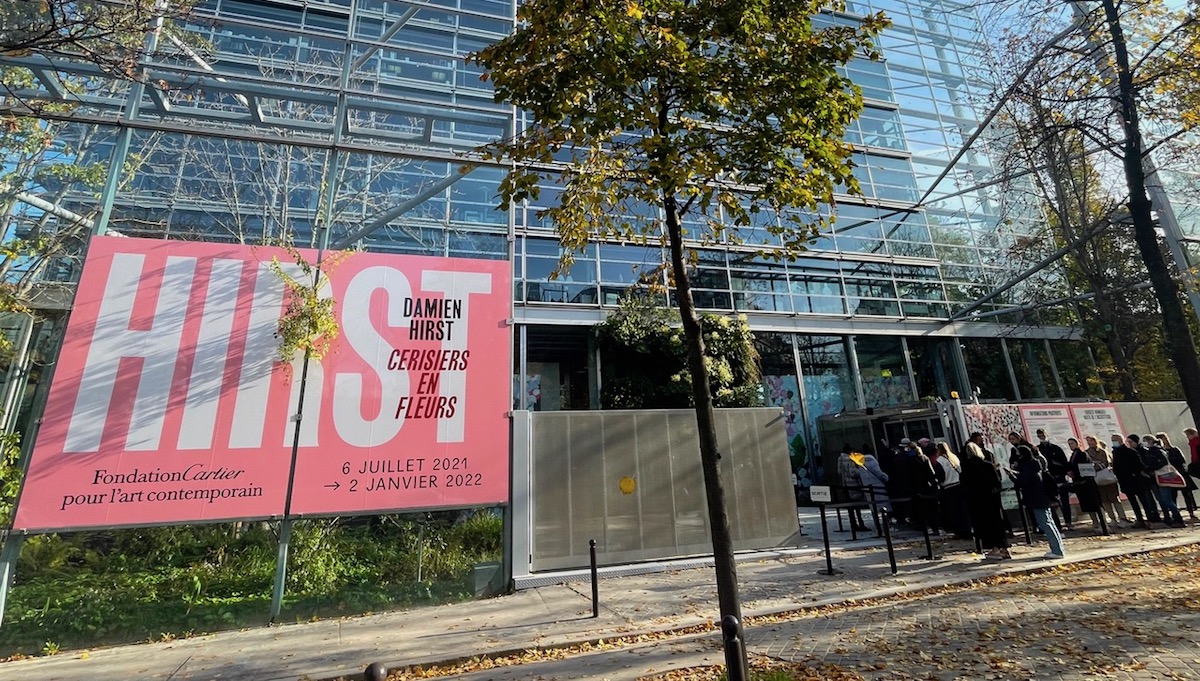Damien Hirst has turned his ‘Cerisiers en Fleurs’ (Cherry Blossoms) series into a full fledged exhibition at the Fondation Cartier Paris. The enfant terrible of the YBA movement has enjoyed a career of more than four decades with blockbusting exhibitions around the globe and sky-high auction prices that peaked with his infamous diamond-encrusted skull ‘For the Love of God’, which sold at auction for over $100 million in 2007.
The Cherry Blossoms are about beauty and life and death. – DH
The day I visited a long queue of devoted art-lovers waited to show their passe sanitaire to enter the airy steel and glass Jean Nouvel designed construction. It was worth the wait, for the collection of brightly coloured canvases inside the galleries were a breath of fresh air.

The floral subject matter and Hirst’s technique, which merges the fluid movement of 20th Century abstract expressionism with the attention to detail of 19th-century pointillism, and the impressionists’ exploration of light, seems perfectly suited to Hirst’s inaugural museum show in the City of Light, the birthplace of Impressionism.
‘Cherry Blossoms’ features 30 large-format paintings selected by Hirst from a complete series of 107 canvases which, displayed together in the high-ceilinged, white-walled galleries with magical Parisian light infiltrating the beautiful architecture of the Fondation Cartier, combine to create an immersive and meditative experience.
Since Hirst is known for his vast number of studio assistants and a Warholian Factory-like system for producing his signature butterfly paintings and spin paintings, the Paris exhibition is something of a departure, for it signals a return to solitary painting in his studio and a move away from his most iconic sculptural works such as the seminal 1991 Shark in formaldehyde (‘The Physical Impossibility of Death in the Mind of Someone Living’), or the huge sculptures featured in ‘Treasures from the Wreck of the Unbelievable’, Hirst’s 2017 Venice Biennale show at Palazzo Grassi, which were a decade in the making.
This move towards a more introspective, painterly way of working coincided with the pandemic and lockdown, which enabled him to revisit a love of painting which he suppressed during his art student days at Goldsmith’s in the 80s when painting was highly unfashionable and conceptual art was perceived as the way forward. Hirst spent three years painting the ‘Cherry Blossom’ series, working on multiple canvases simultaneously, and completing it in November 2020.
“The pandemic has given me a lot more time to live with the paintings, and look at them, and make certain that everything’s finished.” Damien Hirst
Although at first glance it might seem tenuous, the lineage between Hirst’s ‘Cherry Blossoms’ and the pickled cows of his ‘Natural History’ sculptures becomes clear, for both subjects comment on the circle of life, on death and rebirth, with blossoms flowering in the spring and disappearing in the autumn. Titles such as ‘God’s Blossom’ and ‘Precious Moments Blossom’ and ‘Wonderful World Blossom’ indicate that Hirst is exploring the transient nature of life through these new canvases, which are an observation of what simple pleasure we can derive from appreciating nature.
The life-affirming splendour of the Cherry Blossoms provides hope and captures the essence of nature’s healing power, something that we all noticed far more during months of lockdown. In this sense, the Cherry Blossoms have a similarly life-affirming aura to David Hockney’s lockdown paintings of his garden in France changing with the seasons, exhibited in ‘The Arrival of Spring, Normandy, 2020’ at the Royal Academy of Arts in London this summer just as lockdown 2.0 ended.
Hirst says of the series: “The Cherry Blossoms are about beauty and life and death. They’re extreme—there’s something almost tacky about them, like Jackson Pollock twisted by love. They’re decorative but taken from nature. They’re about desire and how we process the things around us and what we turn them into, but also about the insane visual transience of beauty—a tree in full crazy blossom against a clear sky.”
“Les Cerisiers en Fleurs parlent de beauté, de vie et de mort. Elles [les toiles] sont excessives – presque vulgaires. Comme Jackson Pollock abîmé par l’amour. Elles sont ornementales mais peintes d’après nature. Elles évoquent le désir et la manière dont on appréhende les choses qui nous entourent et ce qu’on en fait, mais elles montrent aussi l’incroyable et éphémère beauté d’un arbre en fleurs dans un ciel sans nuages.”
Damien Hirst was born in 1965 in Bristol and moved to London in 1984 where he studied at the Goldsmith’s College of Art, gaining notoriety after curating ‘Freeze’, the graduate show for the class of 1989, which was the naissance of a new movement of artists known as the YBAs and attracted the attention of Charles Saatchi, Nicholas Serota and Norman Rosenthal. And the rest, as they say, is history.

Maybe Hirst has mellowed with age, or perhaps he just stopped and stood still for long enough during the pandemic to notice the sublime beauty of nature and realise how important it was to capture that for eternity. As Europe slides into another winter of lockdowns with the fourth wave of the pandemic, if you can get to Paris before more travel restrictions are imposed, go to the Cartier Foundation and soak up the light and energy of the beautiful ‘Cherry Blossom’ paintings, then tuck it away in the recesses of your memory to access on a wintry lockdown day, as a reminder that however dark the days of winter can be, there will always be spring.
Words & photos Lee Sharrock © Artlyst 2021
Damien Hirst ‘Cerisiers en Fleurs’ is at the Fondation Cartier in Paris until 2nd January 2022

